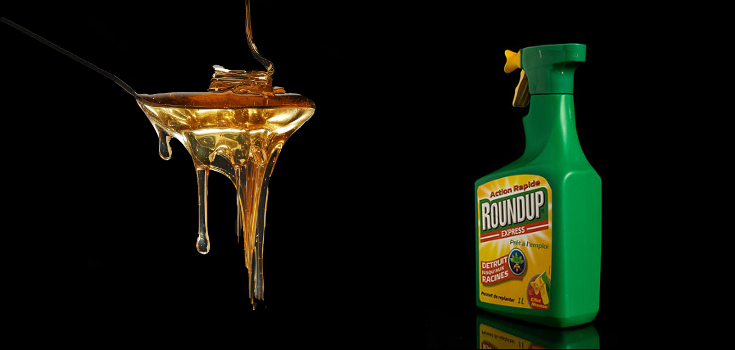Researchers Discover Glyphosate Herbicide in Honey, Soy Sauce

How ubiquitous is Monsanto’s RoundUp herbicide, really? Researchers have discovered that a chemical in the world’s most used herbicide – RoundUp – is tainting the world’s food supply at large. It was recently found that this chemical, known as glyphosate, is present concerning amounts in honey and soy sauce.
For the study, researchers from Abraxis LLC and Boston University purchased sample sizes of various foods to analyze levels of glyphosate. Bought from the Philadelphia, US metropolitan area, the following foods were analyzed:
- 69 samples of honey
- 26 samples of pancake and corn syrup
- 28 samples of soy sauce
- 11 samples of soy milk
- 20 samples of tofu
The minimum limit of quantification (LOQ) of the method were determined for honey, pancake syrup, and corn syrup to be 15 ppb; soy sauce, soy milk, and tofu 75 ppb. What this means is that products could have contained minimal levels of glyphosate even though they turned up negative.
While glyphosate residues above the limit weren’t detected in the soy milk, pancake and corn syrup, and tofu, shocking residues were found in the honey. Of the 69 honey samples tested, 41 of them (59%) had glyphosate concentrations above the method LOQ (15 ppb), with a concentration range between 17 and 163 ppb and a mean of 64 ppb.
And it wasn’t just commercial honey that was tainted; 5 of the 11 samples of organic honey contained high levels of glyphosate – with a range of 26 to 93 ppb and a mean of 50 ppb.
Sustainable Pulse Director Henry Rowlands reacted Thursday to the published results;
“This sad news shows just how widespread glyphosate is in our food. With the increase in GM crops being cultivated worldwide it is becoming increasingly difficult to avoid. If you ask anyone if they feel there should be ‘allowed’ levels of toxic chemicals such as glyphosate in their bodies the answer will of course always be ‘No’. It is a fact that the scientific and regulatory process cannot evidence ‘safe’ levels for these chemicals.”
Sustainable Pulse notes:
“The results showed that honey from countries that permit GM crops contained far more glyphosate than honey from countries which limit or prohibit the cultivation of GM crops, with the levels in the U.S. by far the highest.”

Approximately 1 billion pounds of pesticides are sprayed on crops in the United States alone every single year, with much of it containing glyphosate. Regulators as well as Monsanto claim that this ingredient is excreted from the body, but numerous studies have shown that not only is it causing numerous health problems, but it is showing up in urine samples, blood samples, and even breast milk.
Despite testing for hundreds of pesticides in food commodities, the USDA does not test for glyphosate residues. Why?

those honey may be used in making chips.
Monsanto is the devil incarnate. It’s a shame they own the politicians lock stock and barrel. It’s funny, they only serve certified organic food in the cafeteria at their headquarters. They don’t even eat their own products. Should tell you something!
I am 66 year old gardener, hobbyist since I was 10.In old country (Poland) we used hoe for weed control. When I was 27, I came to US & immediately I started to use Roundup. Safe, breaks down when it hits the soil(box said that), great. But I noticed that worms, night crawlers(soil builders) disappear. Every year recommended spray dose doubles, weeds get resistant to it. In the begging, next day weeds were dead, today you have to wait weeks or does not work at all. Crops are getting smaller & smaller because the chemical does not break down as promised, but stays in the soil for the next year. The price of the staff goes up every year & costs more then value of your crops. I stopped using this crap years ago & went back to the hoe. Warms are back, crops are huge, no money spent for stupid, useless, poison. I recently purchased large amount of buckwheat honey, cheap. How to test it for Roundup?
So what happens when Monsanto kills everyone, and has all of their money?
“Regulators as well as Monsanto claim that this ingredient is excreted from the body, but numerous studies have shown that not only is it causing numerous health problems,”
Sources please. Hyperbole is not a source. Please link to studies that demonstrate that glycophos is causing health problems. When you make a claim like this it is your responsibility to provide sources.